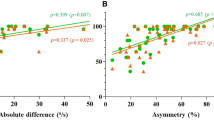Abstract
We investigated the effects of dalfampridine, the sustained-release form of 4-aminopyridine, on slow phase velocity (SPV) and visual acuity (VA) in patients with downbeat nystagmus (DBN) and the side effects of the drug. In this proof-of-principle observational study, ten patients received dalfampridine 10 mg bid for 2 weeks. Recordings were conducted at baseline, 180 min after first administration, after 2 weeks of treatment and after 4 weeks of wash-out. Mean SPV decreased from a baseline of 2.12 deg/s ± 1.72 (mean ± SD) to 0.51 deg/s ± 1.00 180 min after first administration of dalfampridine 10 mg and to 0.89 deg/s ± 0.75 after 2 weeks of treatment with dalfampridine (p < 0.05; post hoc both: p < 0.05). After a wash-out period of 1 week, mean SPV increased to 2.30 deg/s ± 1.6 (p < 0.05; post hoc both: p < 0.05). The VA significantly improved during treatment with dalfampridine. Also, 50 % of patients did not report any side effects. The most common reported side effects were abdominal discomfort and dizziness. Dalfampridine is an effective treatment for DBN in terms of SPV. It was well-tolerated in all patients.


Similar content being viewed by others
References
Baloh RW, Spooner JW (1981) Downbeat nystagmus: a type of central vestibular nystagmus. Neurology 31:304–310
Hufner K, Stephan T, Kalla R et al (2007) Structural and functional MRIs disclose cerebellar pathologies in idiopathic downbeat nystagmus. Neurology 69:1128–1135
Kalla R, Deutschlander A, Hufner K et al (2006) Detection of floccular hypometabolism in downbeat nystagmus by fMRI. Neurology 66:281–283
Zee DS, Yamazaki A, Butler PH, Gucer G (1981) Effects of ablation of flocculus and paraflocculus of eye movements in primate. J Neurophysiol 46:878–899
Marti S, Straumann D, Buttner U, Glasauer S (2008) A model-based theory on the origin of downbeat nystagmus. Exp Brain Res Experimentelle Hirnforschung Experimentation cerebrale 188:613–631
Kalla R, Glasauer S, Buttner U, Brandt T, Strupp M (2007) 4-aminopyridine restores vertical and horizontal neural integrator function in downbeat nystagmus. Brain:J Neurol 130:2441–2451
Kalla R, Glasauer S, Schautzer F et al (2004) 4-aminopyridine improves downbeat nystagmus, smooth pursuit, and VOR gain. Neurology 62:1228–1229
Kalla R, Spiegel R, Claassen J et al (2011) Comparison of 10-mg doses of 4-aminopyridine and 3,4-diaminopyridine for the treatment of downbeat nystagmus. J Neuro-ophthalmol:Off J North Am Neuro-Ophthalmol Soc 31:320–325
Strupp M, Schuler O, Krafczyk S et al (2003) Treatment of downbeat nystagmus with 3,4-diaminopyridine: a placebo-controlled study. Neurology 61:165–170
Etzion Y, Grossman Y (2001) Highly 4-aminopyridine sensitive delayed rectifier current modulates the excitability of guinea pig cerebellar Purkinje cells. Exp Brain Res Experimentelle Hirnforschung Experimentation cerebrale 139:419–425
Alvina K, Khodakhah K (2010) The therapeutic mode of action of 4-aminopyridine in cerebellar ataxia. J Neurosci:Official J Soc Neurosci 30:7258–7268
Hayes KC, Katz MA, Devane JG et al (2003) Pharmacokinetics of an immediate-release oral formulation of Fampridine (4-aminopyridine) in normal subjects and patients with spinal cord injury. J Clin Pharmacol 43:379–385
Hayes KC, Potter PJ, Hsieh JT, Katz MA, Blight AR, Cohen R (2004) Pharmacokinetics and safety of multiple oral doses of sustained-release 4-aminopyridine (Fampridine-SR) in subjects with chronic, incomplete spinal cord injury. Arch Phys Med Rehabil 85:29–34
Spiegel R, Rettinger N, Kalla R et al (2009) The intensity of downbeat nystagmus during daytime. Ann N Y Acad Sci 1164:293–299
Acknowledgments
This work was supported by the German Ministry of Education and Research (BMBF), Grant No. 01EO0901 to the German Center for Vertigo and Balance Disorders (IFBLMU). We thank Ms. Katie Ogston for copy-editing the manuscript.
Conflicts of interest
Dr. Jahn reports ongoing research support from Biogenldec GmbH (lTT on 4-aminopyridine, Fampyra™). Dr. Schneider reports ongoing research support from Autronic Medizintechnik GmbH.
Ethical standard
Study has been performed in accordance with the Declaration of Helsinki and its later amendments.
Author information
Authors and Affiliations
Corresponding author
Additional information
J. Claassen, K. Feil contributed equally to the article.
Rights and permissions
About this article
Cite this article
Claassen, J., Feil, K., Bardins, S. et al. Dalfampridine in patients with downbeat nystagmus—an observational study. J Neurol 260, 1992–1996 (2013). https://doi.org/10.1007/s00415-013-6911-5
Received:
Revised:
Accepted:
Published:
Issue Date:
DOI: https://doi.org/10.1007/s00415-013-6911-5




